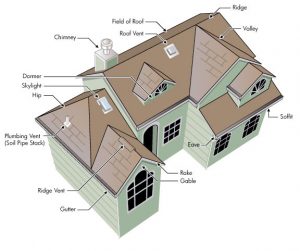There is more to a home’s roof that meets the eye.

Whether you need a roof repair or a new roof, it’s helpful to understand the basic roofing components and materials.
Chimney – a pipe through which smoke or gas goes up into the air, usually through the roof of a building.
Gutter – shallow troughs fixed beneath the edge of a roof, with the sole purpose of carrying off rainwater.
Valley – a hollow resembling or suggesting a valley, as the point at which the two slopes of a roof meet
Chimney Cap – a cap or cover for a chimney; they help keep animals and rainwater out, block downdrafts, block debris and help stop sparks and embers
Vent Stack – an opening designed to convey air, heat, water vapor or other gas from inside a building or a building component to the atmosphere.
Attic Vent – part of an attic ventilation system that replenishes fresh air through the attic space.
Ridge Cap/Vent – a ridge cap is a material or covering applied over the ridge of a roof; a ridge vent is a ventilator located at the ridge that allows the escape of warm and/or moist air from the attic area or rafter cavity.
Fascia – a board that is nailed to the ends of a roof rafter; sometimes supports a gutter.
Soffit – the exposed undersurface of any exterior overhanging section of a roof eave; soffit vents (an air inlet source as part of attic ventilation) are often installed in soffits.
Counter Flashing – flashing is used to weatherproof or seal roof system edges at perimeters, penetrations, walls, expansion joints, valleys, drains and other places where the roof covering is interrupted or terminated. Counter flashing is a strip of sheet metal in the form of an inverted L built into a vertical wall of masonry and bent down over the flashing to make it watertight.
Hip Ridge – a material or covering applied over the ridge of a hip roof